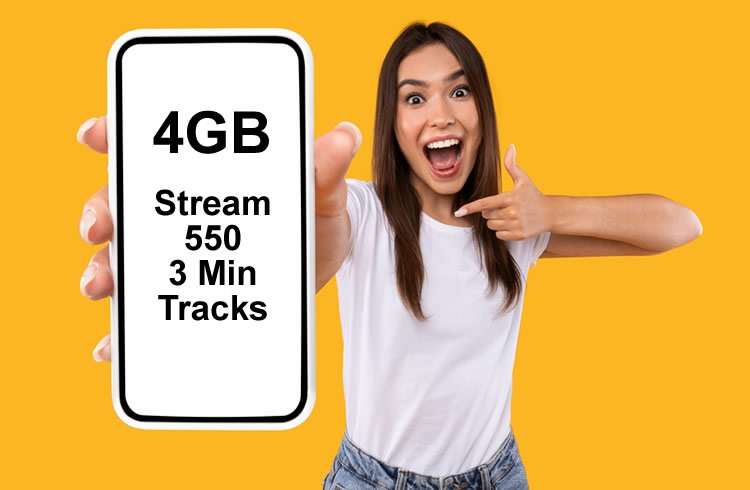
Introduction
When you’re shopping for a new phone deal, a key factor determining how much you’ll pay is how much data you’re going to use. 4GB of data might seem like a reasonable amount at first, but how much browsing and content does 4GB of data really allow?
Knowing exactly what you can do with 4GB of data is important, as it could save you some significant cash on your phone plan, and ensure you’re not paying for more or less data than you need.
Most plans include unlimited text messages and calls already, so it’s usually your data usage which determines whether you’ll be paying more or less. The less data you use, the more money you’ll save. Let’s take a look at what you can do with 4GB of data.
What can I do with 4GB of Data?
|
How many hours will 4GB last?
|
|
Internet browsing
|
40 hours+
|
|
Music listening
|
28 – 94 hours, depending on quality
|
|
Watching video
|
1 hour and 20 minutes to 24 hours depending on your content quality
|
|
Browsing social media
|
44 hours scrolling
|
|
Video calls
|
4-34 hours
|
Ultimately, the amount of time you’ll be able to spend browsing the internet with 4GB of data, and completing other tasks will vary depending on what you want to do.
If you’re not sure how much mobile data you need, it can be helpful to get an insight into the average usage of most people. It’s difficult to know for certain how much data people use these days, but Three reported that during the first half of 2024, its customers used on average 30.5GB per month.
Notably though, Three’s customers are likely to use higher quantities of data than others, as Ofcom’s Communications Market Report for 2024 found the average person uses around 9.9GB per month.
Of course, it is possible to use less data, depending on how you access your phone. The above Ofcom report suggests that level of data use is in large part down to a desire to stream video – so if that’s not something you do, you might be fine with less.
Spusu SIM Deal
1GB Data
Unlimited Mins
Unlimited Texts
£2.90 a month1 month contract
Spusu SIM Deal
5GB Data
Unlimited Mins
Unlimited Texts
£4.50 a month1 month contract
Three SIM Deal
40GB Data
Unlimited Mins
Unlimited Texts
£7.00 a month12 month contract
Internet browsing
|
Normal internet browsing
|
|
4GB of Data
|
1,365 web pages
|
4GB of data is around 4,000MB, while loading a web page will typically use 3MB or less. On average then, 4GB of data will allow you to view upwards of 1,365 web pages. Converting that to an amount of time spent browsing is tricky since it will depend on how long you spend on each page, but online estimates put it at around 40 hours.
Audio data
|
Songs streamed on Spotify
|
|
4GB of data
|
Around 550+ songs
|
If you’re streaming music to your smartphone, each song will have a specific data value connected to it. On Spotify, the average size of a song will depend on both its length, and the audio quality.
A 320kbps song will use approximately 2.4MB of data per minute. This means a 3-minute song will cost around 7.2MB of data. With 4GB of data, you’ll be able to stream around 568 full 3-minute tracks at 320kbps.
However, if you stream at a lower quality, you’ll be able to listen to a higher number of songs. At a quality of 96kbps, 4GB will get you anywhere up to 1,896 songs (2.16MB per song). Here’s an insight into the amount of data used by different audio qualities: 320kbps: 144MB per hour, 160kbps: 72MB per hour, 96kbps: 43.2MB per hour and 24kbps: 10.8MB per hour.
You probably won’t want to stream at 24Kbps, but using the other examples that means you could stream roughly between 28 and 94 hours of music with 4GB of data, depending on the quality.
Video data
|
Netflix video streaming (on phone)
|
|
4GB of data
|
Up to around 12 Netflix films
|
Video consumes a lot more data on average than a song, because you’re processing both visual, and audio content at the same time. The amount of data you use to watch video will vary depending on which streaming service you choose. Let’s use Netflix as an example.
Netflix claims you can watch around 16 hours of content with 4GB of data, or 4 hours for every 1GB. However, you’ll need to use the app on “Automatic” quality to balance video quality and data usage.
However, if you switch to “Save Data” mode, you can increase your streaming potential to around 6 hours per GB, or 24 hours for 4GB of data – enough for 12 two-hour movies. The highest possible resolution for Netflix videos will consume upwards of 1GB of data every 20 minutes. This means you’ll have around an hour and 20 minutes of video content available for 4GB.
Notably, these figures are only applicable to the mobile app for Netflix. Desktop and TV variations of the app stream at different levels, and different streaming services also have slightly different levels of data use.
Social media data
|
Social media use examples for 4GB of data
|
|
Social media browsing
|
Around 40 hours
|
|
WhatsApp video calls
|
4-27 hours of chat time
|
|
FaceTime video calls
|
10-34 hours of chat time
|
|
Photos on WhatsApp
|
Approximately 4,000 photos
|
If you’re using your phone for social media, the amount of data you’ll use depends on how you’re going to use your social channels. You could send over 400,000 WhatsApp messages with 4GB of data, however, if you want to share photos or video, your data use will increase.
A video call on WhatsApp will use anywhere from 2.5MB to 15MB of data per minute, or 150MB to 900MB per hour. This means you’ll get anywhere from 4 to 27 hours of video from WhatsApp calls with 4GB of data. Alternatively, Skype and FaceTime are slightly more efficient, with FaceTime for example using between 120MB and 380MB per hour, so you could make between 10 and 34 hours of video calls with 4GB of data.
If you’re sending images through social media, the amount of data you use will depend on the size of the photo file. But often, WhatsApp will keep files to a megabyte at maximum if you switch to Data Saver mode. This allows you to send up to 4,000 photos through your social app.
How can I see my data use?
While looking at average data consumption numbers can be helpful, it’s often much more effective to examine your own specific data situation. To decide how much data you need personally, you can usually find your data usage numbers on your account page or app for your mobile network.
Details of this can also often be found directly on your phone. If you have an Android device, go into the “Settings” section of your phone, then click on “More Network Settings”. Here, you should see a “Data Usage” subheading. Alternatively, you can go to Settings, then click “Connections”, followed by “Data Usage”.
On an iPhone (iOS), visit the “Settings” page, followed by either “Mobile Service” or “Cellular”, depending on the type of phone you have.
Usually, you’ll be able to see how much data you’ve used in your previous billing period, or over the last month. On some devices you can also set alerts when you’re about to reach your data cap, or set a “data limit” on your phone to stop you from going over your allowance. There’s usually a “Data warning & Limit” section to help with this.
Can I save on data use?
Reducing your data consumption is a good way to save money. To do this, you’ll need to keep a close eye on your data usage, so make sure you know how to watch your data consumption on your phone. It’s also helpful to stick to Wi-Fi connections wherever possible.
When you’re leveraging Wi-Fi, you won’t use any of your phone’s data allowance. Another way to cut data usage is to go into the settings for each app you use regularly on your phone, and adjust the data settings. You can switch to “Data Saver” mode for some apps, and adjust the quality settings on video and audio streaming apps to “low”.
Some apps will also allow you to specifically use a lower quality stream when you’re using mobile data, then switch to higher settings when you’re connected to Wi-Fi. You can sometimes even download content when you’re on a Wi-Fi connection, to view at a later time without data usage.
Should I have more than 4GB of data?
The amount of data you need really depends on how you plan on using your phone. If you’re just occasionally checking the internet and browsing social media, you should be able to get by with 4GB of data. However, if you’re going to be streaming a lot of high-quality music and videos regularly, or making video calls, you may need more data.
If you’re still unsure, then it’s worth searching for a deal with your that allows you to adjust your contract according to your data usage each month – 30-day rolling plans come with this flexibility, as do some others. Alternatively, you can measure your data for a while and get to know your consumption average before you find a contract.














